
Cry Wilderness (1986), a low budget family film, feels as though it were made twenty years too late. The release of Cry Wilderness may coincide with that of Harry & The Hendersons (1987) but the aesthetic of the film, the amount of nature footage, makes it akin to the nature films that Disney aired on television during the sixties. There’s little plot to Cry Wilderness but there’s plenty of spectacle of a young boy frolicking in the woods with adorable animals.
The protagonist of Cry Wilderness is a little boy named Paul (Eric Foster). One night, as Paul sleeps soundly in the dormitory of a private school, he is awakened by Bigfoot standing on the lawn and yelling out a warning that Paul’s father is in danger (Paul’s mother is never mentioned nor seen). Paul promptly runs away, hitchhiking out to the remote North Western forest where his dad is the head ranger. It turns out that Paul’s father, Ranger Cooper (Maurice Grandmaison), and his Native American partner Jim (John Tallman) are trying to catch a Siberian Tiger who has escaped a circus. Things are only further complicated when Morgan (Griffin Casey) arrives to help the rangers and to shoot Paul’s best friend the Bigfoot.
Cry Wilderness has such a high profile for being a bad movie that Mystery Science Theater 3000 did an episode riffing on Cry Wilderness. Acclaimed screenwriter Philip Yordan was famously hired to write the script for Cry Wilderness but was told by the owners of Visto International Inc. that his script should have no sex, violence, horror, or anything that might upset a small child. Yordan’s screenplay is so un-complex that it’s almost about nothing. Most of Cry Wilderness is composed of cutaway shots to cute animals that pad out half an hour worth of plot. In these moments where story is given precedence the focus is on Paul’s longing for his father figures (Bigfoot and his biological dad) and on Native American mysticism that’s been appropriated by Yordan to give the world of the film some dimension.
The climax of Cry Wilderness is a scene that is totally at odds with the rest of the film tonally. In this climactic sequence the hunter Morgan pursues Bigfoot onto the sacred grounds of some unnamed tribe. Paul has taken a short cut to reach this magical place before Morgan. When the hunter arrives he finds Paul, a Native American shaman of some kind, and Bigfoot standing together, flanked by eagles and pumas, waiting for Morgan. The big game hunter raises his rifle to take aim when the magic stones worn as a necklace by Paul and the shaman light up and spring an eagle into action. The bird of prey lunges for Morgan and rips out his eyes, blinding him for having looked upon the sacred Bigfoot. Cry Wilderness, in this moment of gore, becomes the antithesis of the film it has been up to that point.
The incredible thing is that Cry Wilderness isn’t that bad, it’s just boring. It’s as entertaining as any live action Disney film from the sixties or seventies. Its reputation as a bad film primarily stems from comparisons with movies made contemporaneously. But clearly the intent of the filmmakers was to make this kind of retro picture for kids. If one judges Cry Wilderness based on the success of the filmmakers to realize their intent then Cry Wilderness is a perfectly competent picture.
